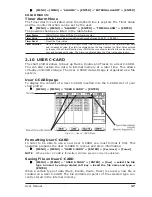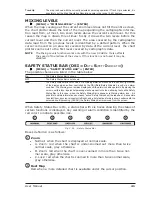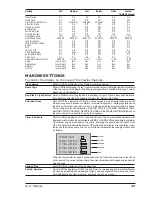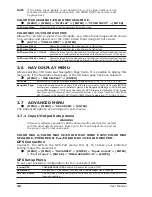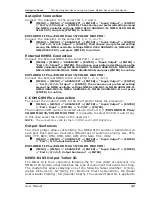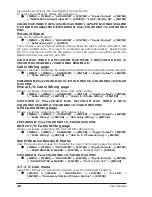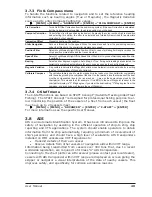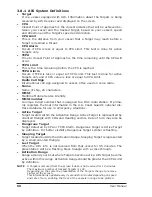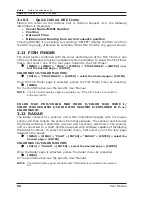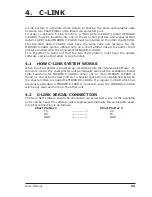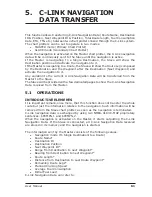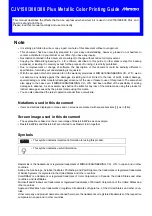
49
User Manual
3.7.3 Fix & Compass menu
To handle the functions related to navigation and to set the reference heading
information such as bearing angles (True or Magnetic), the Magnetic Variation
source and to enter Compass Calibration values.
[MENU] + [MENU] + "ADVANCED" + [ENTER] + "FIX & COMPASS" + [ENTER]
Fix Correction
: Turns On/Off the Correction from the positioning system. If the new Correction is calculated,
but the Correction is not enabled, the ship's position is not changed.
Compute Correction
: Corrects fixes from the positioning instrument. By placing the cursor on the ship's real position
and selecting this option, the error is calculated and internally memorized for appropriate
correction, but not applied.
Correction Offset
: Manual correction of fix position.
Static Navigation
: Sets up a threshold for the speed. When the speed received from the positioning device is
under that threshold, the chartplotter displays zero speed.
Position Filter
: Selects Low/Medium/High/Off the Position Filter. In case of a jittering fix this option makes the
ship's position more stable and the track smoother.
Speed Filter
: Selects Low/Medium/High/Off the Speed Filter. When it is On, you can filter the speed of the ship,
to optimize it.
Bearing
: Selects either degrees magnetic, Auto Mag, or True. If magnetic readings are selected the
variation is computed automatically for every zone as soon as the chart is displayed.
Magnetic Variation
: It is possible to calculate the Magnetic Variation in an Automatic or manual mode, by inserting
the step for calculation of Magnetic Variation.
Calibrate Compass
: The variation table is used to match magnetic value readout on the chartplotter comparable
with the value given by the compass of the boat. In other words, since the compass of the boat
must be compensated (due to the iron masses, ...), we use the same values given by the
chartplotter. This means that, for example, if the BRG to the next Waypoint readout in the
chartplotter display is "X" Mag degree, if you steer the boat reading "X" Mag degree from the
compass, you are driving well toward the next Waypoint.
3.7.4 C-Staff menu
The C-Staff functions are based on STAFF Concept
®
(Satellite Tracking Aided Fleet
Fishing). The STAFF Concept
®
is designed for professional fishing purpose to al-
low monitoring the position of the vessels of a fleet from each vessel (the fleet
may have up to 20 vessels max).
[MENU] + [MENU] + "ADVANCED" + [ENTER] + "C-STAFF" + [ENTER]
For more information see the specific User Manual.
3.8
AIS
AIS is an Automatic Identification System. It has been introduced to improve the
safety of navigation by assisting in the efficient operation of ship-to ship, ship
reporting and VTS applications. The system should enable operators to obtain
information from the ship automatically, requiring a minimum of involvement of
ship’s personnel, and should have a high level of availability. AIS transponders
installed on IMO vessels use VHF frequencies to:
♦
Transmit details of their own vessel
♦
Receive details from other vessels or navigation aids within VHF range.
Information being transmitted from vessels over 300 tons that, due to recent
worldwide legislation, are required to fit Class “A” AIS transponders.
Connecting to the chart plotter an AIS receiver (please contact your local dealer),
vessels with AIS transponder within VHF range are displayed on screen giving the
skipper or navigator a visual interpretation of the data of nearby vessels. This
improves safety, and specifically for collision avoidance reasons.
Summary of Contents for COLOR MAX 15
Page 20: ...22 User Manual...
Page 56: ...58 User Manual...
Page 58: ...60 User Manual...
Page 78: ...80 User Manual...
Page 84: ...86 User Manual...
Page 96: ...98 User Manual...



